Home » Diet & Food » The Crazy Food Fight Over The Future of Vegetables
The Crazy Food Fight Over The Future of Vegetables
On a cold, rainy night in Brooklyn, a crowd gathers inside the building that houses Square Roots, a company cofounded by CEO Tobias Peggs, a tech entrepreneur, and Kimbal Musk, who sits on the boards of Tesla and SpaceX (both started by his older brother, Elon) as well as Chipotle. Located on a dreary street in Bedford-Stuyvesant, the building is, technically, a farm. Its parking lot holds ten enclosed shipping containers.
With a bit of showmanship, Peggs throws open the door to one of the containers and a violet glow envelops the crowd. Inside, tightly packed vertical rows of red leaf lettuce, basil, and mint grow hydroponically through a combination of artificial light and a nutrient-rich solution. Musk and Peggs say they can cultivate three acres of plants in one container using a technique that could be adopted by any city in the world.
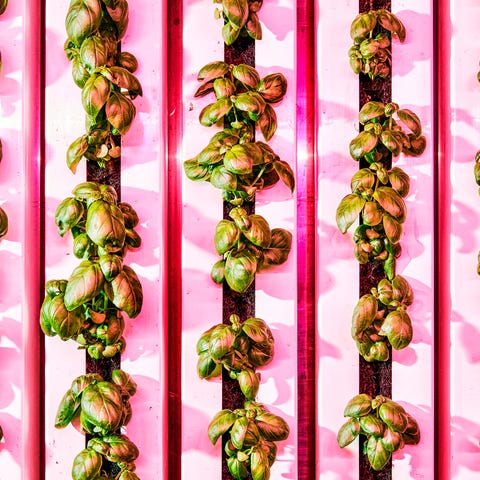
Christopher Testani
At the heart of the vertical-farming trend championed by Musk and Peggs is the idea that although you can find lettuce at your grocery store in Boston in January, thanks to a system that allows farms in states like California and Arizona to ship fresh greens across the country at a reasonable cost, there are better alternatives.
Growing lettuce outdoors on a large-scale farm uses a lot of water. Plus, it’s estimated that during the up-to-five-day domestic trip from these farms to the grocer, the greens lose much of their nutritional value.
About 35 miles north of Brooklyn, a back-to-the-future approach to farming is growing. A few days later, I join Jack Algiere, the farm director of Stone Barns Center for Food and Agriculture in Pocantico Hills, New York, and we walk along a hillside path with cows and lambs grazing on one side, goats frolicking on the other.
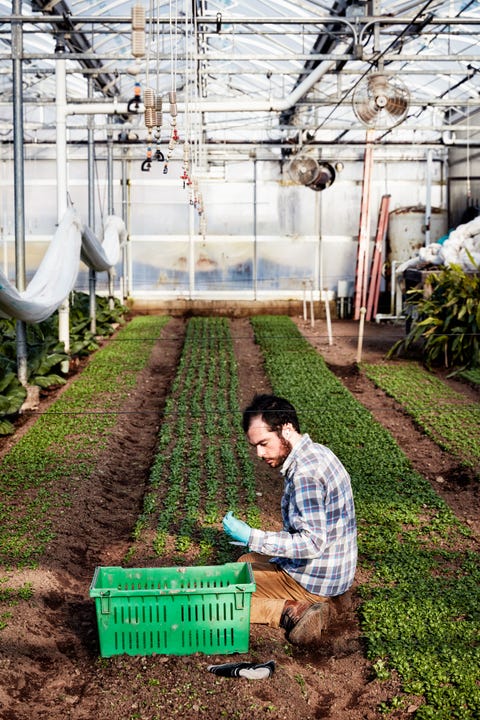
Christopher Testani
Dressed in a flannel shirt and a sturdy coat, Algiere enters a half-acre greenhouse. Lettuce leaves the size of a baby elephant’s ears luxuriate in the warm air. Purple and yellow stalks of chard erupt from the earth, which is dark brown and lush.
Algiere treats this food with the same care and attention as Dan Barber, a top chef. Barber runs Blue Hill at Stone Barns, a farm-driven restaurant that consistently ranks as one of the best restaurants in the world.
You would think the viewpoints of Musk and Barber, two of the most influential voices in farming, would be closely aligned, but their debate about how to grow lettuce is getting heated and dirty.
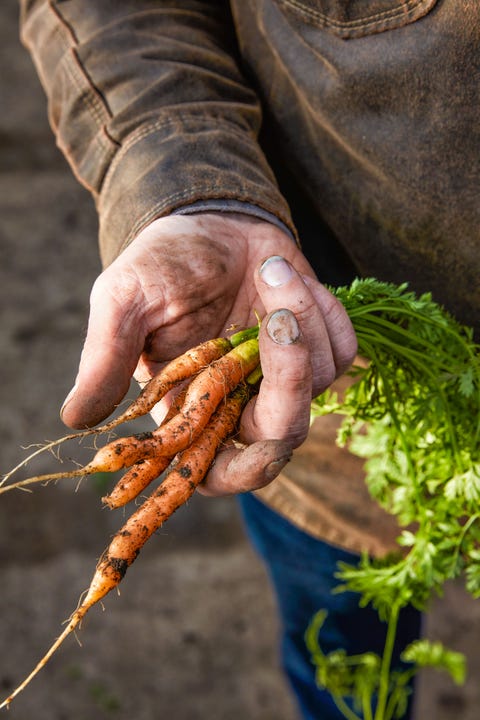
Christopher Testani
Barber: “[Kimbal’s] really smart, but the only reason he wants everyone to eat salad in the winter is because it’s the only thing he can grow in a vertical farm. He’d be telling you he’d want everyone to eat rutabaga if he could grow rutabaga. I love the guy, but let’s be honest: You can’t grow anything.”
Musk: “I don’t think [Dan] has a fundamental disagreement with what I’m doing. He sees the momentum moving towards indoor farming, and he doesn’t like that future.”
What’s at stake is billions of dollars and the future of food on the planet. Over the past 50 years, large farms growing massive amounts of one crop (known as monoculture) have gobbled up land. While industrial farming has increased crop yields, it’s done so at the expense of consumer choice.
In a span of 80 years, the variety of the world’s seeds dwindled by 93 percent, according to the Rural Advancement Foundation International: In 1903, 497 types of lettuce existed, but by 1983, there were just 36.
Industrial farming is so chemically reliant and ultimately bad for the soil (not to mention bad for the diets of those who live on its produce) that the United Nations’ 2013 trade and development conference urged a global return to sustainable farming practices.
Nowhere are the consequences of industrial farming more evident than at your supermarket, where identical-looking potatoes, carrots, and greens line the produce shelves. The presentation looks attractive, but that sameness is a result of destructive land-management practices—practices that lead to less-nutritious produce.
And then there’s foodborne illness. Remember the Great 2018 Romaine Lettuce Scare? Investigators traced that outbreak back to a large-scale farm in Santa Maria, California.
“It’s not like this is the question we should be thinking about five generations from now,” Barber says. “This stuff takes a long time, but time is running out.”
The Musks Shall Inherit the Earth
Square Roots may be the least splashy of all of Kimbal Musk’s endeavors. The South African native became involved in the food world after making millions building and selling start-ups, both on his own and with his brother. He did a stint in culinary school in New York City, then settled in Boulder, Colorado.
Lost in the shadows of the Musk sibling mythology is that Kimbal is actually a legitimate farm-to-table pioneer. He opened his first restaurant, the Kitchen, in 2004, sourcing ingredients from Colorado’s rich agriculture and livestock communities.
Musk launched Square Roots with Peggs in 2016 with one concept: “Can we take a young person with no experience and bring them in and teach them how to farm in a box in double-quick time and get them to grow food that is tasty, that people want to eat?”
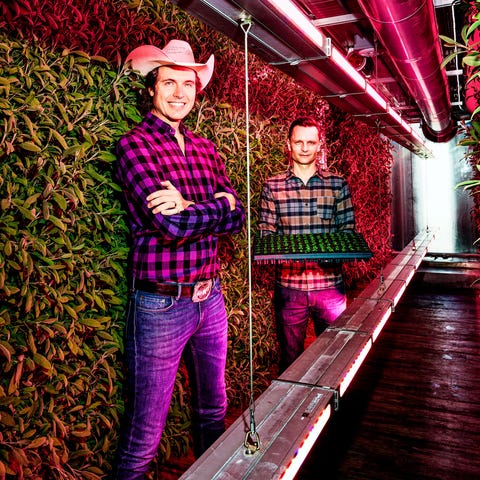
The initial results were encouraging, although Square Roots cycled through distribution concepts before arriving at its current direct-to-retail model. You can now find Square Roots’ greens and herbs at specialty grocers around New York City.
Later this year, the company plans to operate in other U. S. cities and then scale from there. In each market, the produce will travel from the shipping containers to nearby store shelves, a solution that is hyperlocal and, now, highly traceable.
During the romaine-lettuce scare of late 2018, when an E. coli outbreak in California led to a coast-to-coast recall, Peggs and Musk realized that the data they compile for Square Roots would allow them to trace everything they grow back to the very shipping container that produced it. Now there’s a “Transparency” section on the company’s website where consumers can enter the lot number from their package of Square Roots herbs.
There are energy concerns with this type of farming, as well as a sense that it isn’t natural, but Musk is leaning into those issues. This is lab-grown food, and his team is sciencing the shit out of it. Strawberries, eggplants, beets, radishes, carrots, and more will come to market in five years.
“Right now we’re super-premium and people love it,” Musk says. “But over time we really want it to be about real food for everyone. We can get the price down and deliver delicious product 365 days a year.”
The Real Dirt on Heritage Farming
Stone Barns Center runs apprenticeship and education programs aimed at training and supporting small farmers. Small-scale farming is knowledge-intensive and complicated, Algiere acknowledges, but it’s the right thing to do for ourselves and the planet.
Watch the news and it’s depressing for farmers, but there was a glimmer of good news in the USDA’s 2017 Agriculture Census. At the same time that the overall number of farms in the United States decreased by 5 percent to only 2 million, farms with annual revenues between $100,000 and $250,000 saw the largest increase in sales between 2016 and 2017.
“This is so important,” says Algiere, launching into a soliloquy about the rising interest of young, first-time farmers and the surprising upswing in the number of small U. S. farms. He grabs a rake and continues his lecture on how small farms on the perimeter of major urban centers can not only thrive but can also conserve the land.
Algiere walks out into a plot of carrots and runs the rake over the greens protruding from the soil, explaining that most of the equipment available to farmers is of the giant John Deere tractor variety, because industrial farming has dominated society since the mid- to late 20th century.
“The problem is that there hasn’t been a set of tools for small-scale, diversified farms since 1940,” he says. That’s why among the many educational endeavors that Stone Barns Center supports is Slow Tools, a collective of farmers, designers, and engineers (with an annual conference held on the property) aimed at manufacturing equipment that can help small farmers grow vegetables and work their five-ish acres more efficiently.
Attendees include retired engineers who’ve developed a desire to farm, prototypical millennials seeking a return to the land, and even city dwellers who got their first taste of farming by working at one of the vertical hydroponic farms.
Barber so believes in Algiere’s work, as well as the entire regenerative-farming and land-management movement, that he cofounded Row 7 Seeds last year. Barber asserts that most of the seed business is now owned by chemical companies that have little interest in small, regenerative farms.
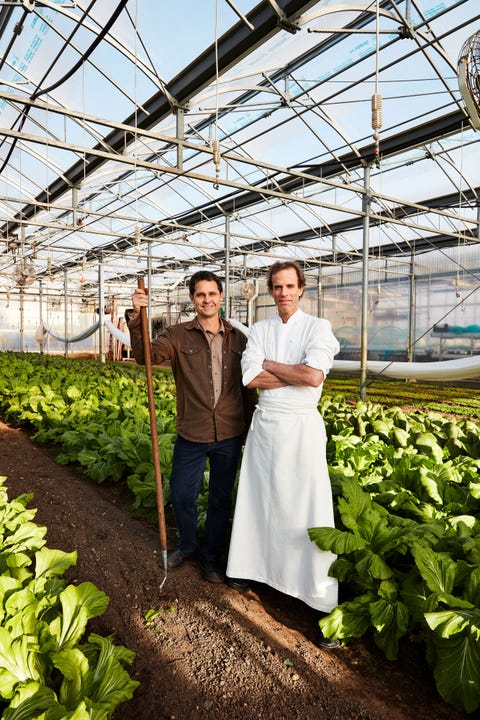
“They don’t make money on the seeds; they make money on the intervention of chemicals,” he says. “That’s why the seed company became so important to me. It really does lay the foundation for everything that follows, including flavor, up to when it hits your mouth. That can be determined on a genetic level.”
Back in the greenhouse, Algiere puts down the rake, heads outside, and walks to a barn filled with hundreds of chickens. They swarm toward him and produce a cacophony of clucks that make it impossible to hold a conversation.
He moves toward the pigs and extends his hand toward a comically large sow that comes to greet him. “My animal operations feed the compost and pasture operation here,” he says. “My compost system feeds the crops and orchards, and any leftover feeds the pigs.” As hogs wrestle playfully, he whispers about how amazing the bacon coming from these animals will taste.
Eat the pork from Stone Barns Center and you will immediately understand what Algiere means. Try its carrots and you’ll come to believe what Barber does. The flavor of these foods—started from diverse seeds (both heirloom and experimental hybrids), coddled by premium soil, cultivated with gentler farming methods—rewards the eater in a way that your typical supermarket versions cannot.
Is it hard work? Algiere’s calloused hands prove that, yes, it is. But it’s not anything we haven’t done before.
The Fight for Farming’s Futures
Chris Newman, who cofounded Sylvanaqua Farms in rural Virginia with his wife in 2013, calls himself a “permaculturist” and proclaims his reverence for the land—but also for technology. “There is no single ‘right’ way to produce food,” he says in an email interview.
His own farming practices aim to be regenerative, like Algiere’s, and he’s adamant that these types of farms can produce food while helping to restore the environment. Yet ultimately they won’t be able to keep up with demand.
“Sooner or later, people on both sides of the debate will have to understand that sustainable food production lies in the intersection of nature and technology, not in their mutual exclusion.”
Call them rigid in their convictions, but Musk, Peggs, Barber, and Algiere are at least stoking the debate about how to feed the planet healthy food. And they’re drawing prominent investors into the search for a resolution.
Investors like Tom Colicchio, a cohost of Top Chef and an early backer of Bowery Farming, a company with two hydroponic farms. “I like what [Barber] has to say, and I also believe that through the right kind of farming and regenerative practices, we can build soil, we can grow,” he says. “That doesn’t help if there’s flooding or drought with climate change. I’m looking at 20 or 30 years down the road, and we’re going to have to rely on indoor farming.”
But then there’s the issue of energy use. Henry Gordon-Smith, a leading consultant on urban agriculture, advises multinational corporations and individuals wanting to start their own vertical, rooftop, or greenhouse farms.
Seated in his Brooklyn office, he recounts a study he conducted for an international beverage company to determine the carbon footprint of five crops grown in three settings: a vertical farm and a greenhouse, both in New Jersey, and a soil-based farm in California.
The results were mixed, depending on the crop, but a key takeaway was that the vertical farm’s carbon footprint was “extraordinarily higher,” due to the energy used. He adds that when you account for food waste, water use, and social impact, the playing field levels a bit, but the bottom line, he says, is “there’s no silver bullet. That’s not the catchy sound bite that people are looking for, but that’s the fact.”
Yet the cash continues to pour into vertical farming. Venture capitalists have pledged about $1 billion over the past two years to fund start-ups like Plenty, AeroFarms, and Bowery Farming. Amazon, Google, and Microsoft are in the game.
Market research projects the global vertical-farming market will hit $10 billion by 2025. Operations like AeroFarms’ 70,000-square-foot facility in Newark, New Jersey, and the 100,000-square-foot farm that Plenty built outside Seattle will soon become commonplace, proponents suggest.
Matt Barnard—the CEO of Plenty, which has amassed more than $200 million from investors like Amazon’s Jeff Bezos and SoftBank, the majority shareholder in Uber—explains that he’s going big because of the scale of the problem.
“I was brought in by one thing and now I’m here for many—for health, nutrition, stresses on the land system,” Barnard says. That mission, however, may depend on trusting in not one solution but a combination of many.
For the moment, the vegetables available at your local farmers market or upscale grocery store reflect this dichotomy. You can easily find a plastic tub of lettuce from a hydroponic farm and, depending on the season, you may also find a sweeter, smaller, more efficient variety of honeynut squash developed in part by Barber and Row 7 Seeds.
Hydroponically grown greens and soil-grown, small-farm-produced squash living side by side in harmony: It’s a utopian vision already playing out in front of your shopping cart. The true question is, will you buy either? The answer, if you’re really concerned about your health and the health of the planet, is that you’ll buy both.
Source: Read Full Article
-
 We Just Found So Many Irresistible KitchenAid Gadget Deals & They're Perfect Holiday Gifts
Dec 10, 2020
We Just Found So Many Irresistible KitchenAid Gadget Deals & They're Perfect Holiday Gifts
Dec 10, 2020 -
 This Christmas pizza wreath recipe is the ultimate Christmas dinner showstopper
Dec 19, 2019
This Christmas pizza wreath recipe is the ultimate Christmas dinner showstopper
Dec 19, 2019 -
 Mum-of-two sheds EIGHT stone after getting stuck in kids’ play area – look at her now
May 6, 2019
Mum-of-two sheds EIGHT stone after getting stuck in kids’ play area – look at her now
May 6, 2019 -
 Ina Garten Uses This Unexpected Ingredient to Pack Her Grilled Cheese With Flavor
Dec 30, 2021
Ina Garten Uses This Unexpected Ingredient to Pack Her Grilled Cheese With Flavor
Dec 30, 2021